Tools Required
It is recommended that the measurer have a good quality 100-foot tape measure with a loop fitting that can be connected to a halyard shackle. The tape should be either metal or fiberglass backed so that it does not stretch. A plumb bob and a level are also useful. All measurements are in decimal fractions of a foot, and should be made to the nearest 0.1 foot.
Rig Measurements
The purpose of rig measurement is to help identify the boat model and, for production boats, to determine whether the rig has been modified. If you haven’t modified your boat at all, then your boat is called a stock boat, and there are a few other options to get your rig measurements:
- check the make and model documentation from your boat manufacturer
- search for your boat make and model on sailboatdata.com
- search our database for boats that are exactly the same make and model as yours
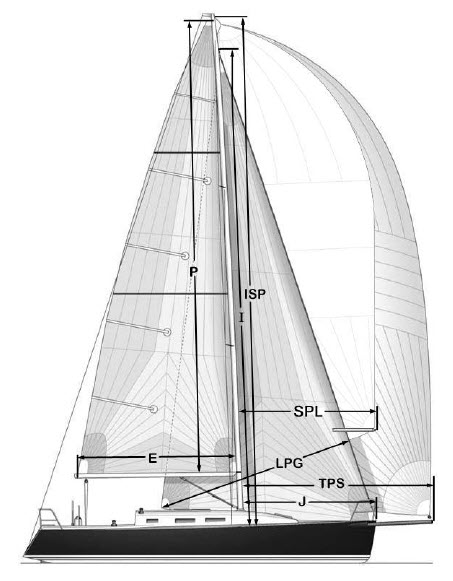
I: In theory, I is the vertical distance between the local sheer line and either the point where the forestay intersects the face of the mast or to the top of edge of the highest headsail halyard sheave, whichever is greater. In practice, it is sufficient to hoist a tape measure with the Genoa halyard and measure the distance to the side deck just inside of the shroud chain plate.
ISP: The theoretical definition of ISP is the distance from the local sheer to the top edge of the highest spinnaker halyard sheave. For our purposes it is sufficient to hoist a tape measure with the highest spinnaker halyard and measure the distance to the side deck just inside of the shroud chain plate.
P: This is the distance from the top of the boom to the bottom of the black band at the top of the mast. Without going up the mast, it is very difficult to see the black band. One method is to hoist the tape measure with the main halyard to the designed P measurement, then use binoculars to see if how close the end of the tape measure is to the bottom of the band. If there is no black band on the mast, hoist the tape as far as it will go and measure the distance to the top of the boom.
E: This is the distance from the back surface of the mast to the inside edge of the black band at the end of the boom. If there is no black band, measure to the outside edge of the outhaul sheave. If there is an external track fitted on the mast, the measurement is taken to the surface of the track.
J: This is the horizontal distance from the point where the forestay intersects with sheer line to the face of the mast. For boats that tack a headsail forward of the forestay, J will be the horizontal distance from the headsail tack point to the face of the mast.
SPL: Set the pole on the mast fitting in a horizontal position and athwart ships. Measure the distance from the center line of the mast to the extreme outboard end of the pole.
TPS: Measure the horizontal distance from the face of the mast to the point of attachment at deck level for deck tacked spinnakers or the extreme forward end of any bowsprit when fully extended for sprit tacked spinnakers.
Sail Measurements
Measure your largest sails, and use units in fractions of feet to the nearest 0.1 foot. When measuring sails, sufficient tension should be applied to remove wrinkles but not to stretch the cloth. If you’re getting new sails, the sail measurements are typically provided by your sailmaker.
Symmetrical Spinnaker: The Spinnaker Luff (SL) is measured along the edges of the sail from the head to the foot. The Spinnaker Maximum Width (SMW) equidistant from the head. The Spinnaker Foot (SF) is the shortest path on the surface of the sail connecting the tack and clew. For most spinnakers the maximum width will be near the center of the sail, but it may also be across the foot.
Asymmetrical Spinnaker: Both the Spinnaker Luff and Leech (ALU and ALE) are measured from head to foot. The Asymmetric Mid Width (AMG) is measured by determining the mid points of the luff and leech and the width is the shortest path connecting those two points. The Spinnaker Foot (SF or ASF) is measured in the same fashion – that is, the shortest path connecting the tack and clew.
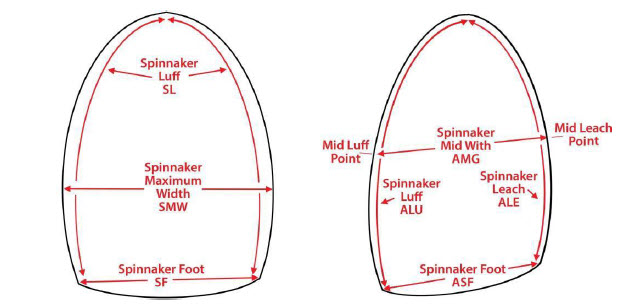
Headsail: The luff perpendicular (LP) is measured from the clew to outside edge of the sail including any luff tape. The perpendicular line can be found by holding the end of the tape at the clew, then determining the minimum distance to the luff by swinging the tape in a small arch. The headsail half width (HHW) is only required for a Large Roach Headsail.
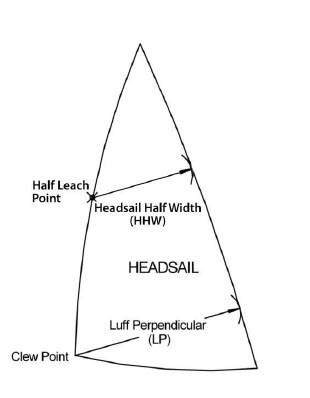
Standard Pinhead Regular Mainsail: PHRF Socal is not asking members to submit the measurements described below at this time. However if you do want to measure your pinhead main, here’s how to do it. Fold the head to the clew (using the corner where the leach intersects the headboard) to locate the half leech point, then fold the head to the half leech point to locate both the one-quarter and three-quarter leech points. Mark these points on the leech. Then fold the head back to the one-quarter leech point to locate he seven-eight leech point. Measure the widths by measuring from the leech point to the nearest point on the luff of the sail including the bolt rope.
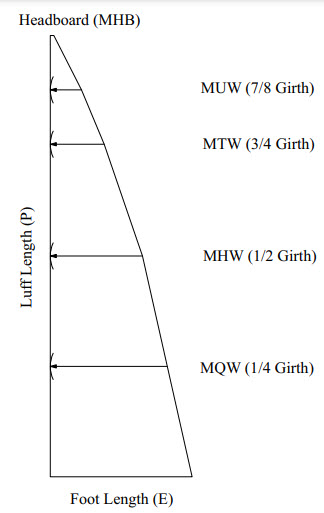
Square-Top, FlatHead Mainsail: The measurements of a square-top mainsail are often contained in sail certificates provided by the sail manufacturer. Your best bet to obtain accurate measurements is directly from your sailmaker. The mainsail parameters that we require are shown below.
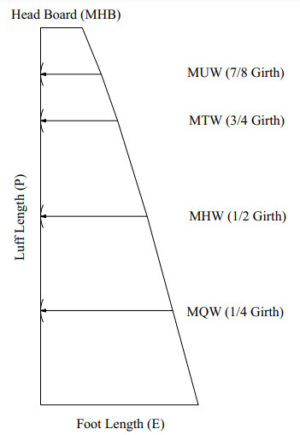
Diagrams and definitions courtesy of Lake Michigan PHRF (except for the mainsail diagrams).
